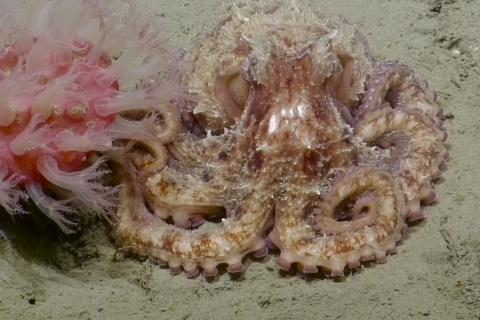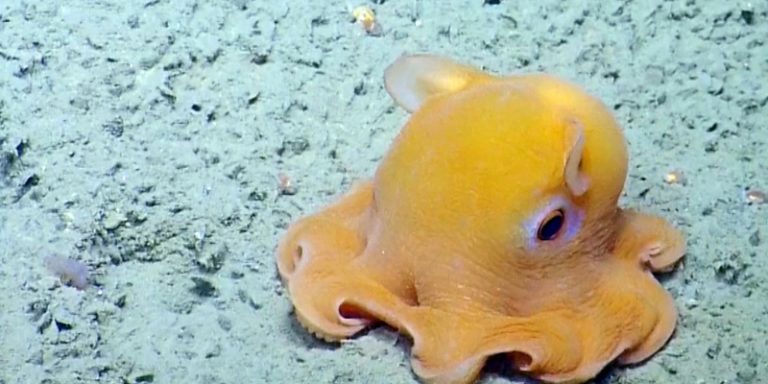

The flexible and long arms of this creature are well-equipped to reach well-hidden places in the crevices where the small fish or crabs are hidden. Consumption of all the prey is primarily dependent on the beak of the octopus. The diet depends on the availability of the prey in its immediate environment.Īs mentioned in the paragraph above, the octopus uses various means to consume and capture its prey. They can diet on lobsters, snails, shrimp, clams, sharks, and various other scallops and crustaceans. To cut it short, an octopus is meat-eating creatures, which means they are carnivores. Octopus eats a variety of foods, and the list of their diet is quite long. Some Octopus hunt during the night and some other species hunt the whole day, from dusk to dawn.
Flapjack octopus full#
Once the prey is in its full control, then the octopus devours the prey first with its beak, then the radula, and if both these don’t work, then salivary papilla comes into play. The octopus, while swimming, captures the prey and envelops it in the web of its tentacles/arm skin, it’s like the octopus’ natural net. The papilla secretes some eroding bodily secretions that erode the shell, and thus the prey becomes weak and is consumed by the predator (octopus). Once the shell opens up, this tongue is used to scrape the animal out of the shell.Īlong with both these deadly tools, there is another tooth-covered organ, which is known as the salivary papilla, this is a natural drill machine in the octopus’ body. The beak not only breaks open clamshells but also can tear the flesh apart.Īlso, there is a radula right next to the beak, which is a barbed tongue. The shells of the animals that can’t be opened with its tentacles are opened within seconds with its beak. The beak is as sharp as a Swiss Army knife.
Flapjack octopus crack#
It is strange but true that octopuses do not have teeth nonetheless, they still can crack up many of their prey that has a hard exoskeleton.Ī well-equipped beak compensates the missing teeth in the octopus, which is just as effective, or maybe more, to break open into the mollusks and the crustaceans. The reason for this gradient is the different chemical composition of the beak at different parts. It has been observed that the remains of the cephalopod beak are found in the stomachs of large predators of octopus, like the sperm whales.Īs you move from the tip to the base of the beak, its stiffness gradually reduces. The octopus beak is primarily made of chitin, but it also comprises of cross-linked proteins that make it even hard to digest by the octopus predators. Octopus can squeeze into any hole that is the size of its beak.The beak can also be termed as jaws or mandibles. The beak works in a scissor-like manner as mentioned before, and this is made possible when the dorsal mandible (upper part of the beak) fits into the ventral mandible (lower part of the beak), and together they move. It has two parts beak, and the parts are, the upper beak and the lower beak.īeak makes hood on the outer side of the mandible that clamps on to the prey to bite it. Octopus’ beak looks very similar to that of a parrot. It’s made out of a hard substance called chitin.Ĭhitin is the same substance that makes the exoskeleton of Crabs. The beak is actually like a jaw, which is stiffer on the outside compared to the inside.


The beak of the octopus is used for eating and works like a scissor. The beak is well surrounded by the long appendages that are an exceptional feature of this species. The buccal mass is the very first part of this creature’s simple digestive system. The beak is situated in the buccal mass section of the Octopus’ body. Octopus beak is the hardest part now left in its body. Octopus now because of its flexible body can capture their prey and evade their predators much easily. This transformation and loss of shell were likely for the better of today’s octopus as it has made the creature more agile. During the Cretaceous and Jurassic period, this marine creature lost its hard ‘mobile home’. They had hard shells all over their body. Researchers say that octopuses weren’t such slimy and squishy creatures many centuries ago. That secret weapon is a scissor-like beak that is well hidden in between all those long whippy arms/tentacles. One of those features is a secret weapon that all octopuses have.


 0 kommentar(er)
0 kommentar(er)
